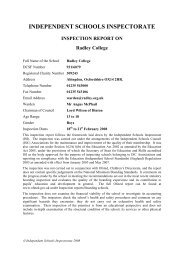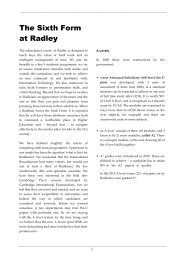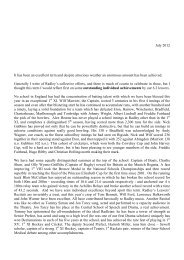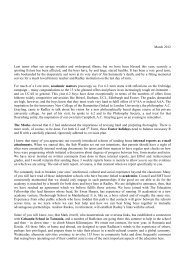N E W S L E T T E R - Radley College
N E W S L E T T E R - Radley College
N E W S L E T T E R - Radley College
You also want an ePaper? Increase the reach of your titles
YUMPU automatically turns print PDFs into web optimized ePapers that Google loves.
Every Wednesday evening Radleians congregate in their boarding houses for ‘Social Prayers’. Talks are given<br />
by dons which may have a moral or spiritual element, often they relate to events in the news, but sometimes<br />
they simply inform the boys about interesting ideas and facts which might not otherwise find their way into a<br />
curriculum. This is an address given by the Acting Warden, Andrew Reekes:<br />
Standing at the bottom of a broad track, alongside<br />
Capability Brown’s picturesque lake, is a gnarled<br />
and twisted oak tree of considerable girth and<br />
obvious antiquity. Since <strong>Radley</strong>’s early days it has<br />
been known as <strong>College</strong> Oak, but <strong>Radley</strong> <strong>College</strong><br />
is a Johnny-come-lately when set alongside this<br />
noble tree, which dendrochronologists from the<br />
EU have recently dated as being c.1060 years<br />
old. In truth, it is one of the oldest extant trees<br />
anywhere in Europe.<br />
Pigs foraging for pannage through the forests<br />
attached to Abingdon Abbey evidently missed a<br />
stray nut. It took root at a time when Edgar the<br />
Peacable, from Wessex, was King of England and<br />
St Aethelwold the Bishop of Winchester held the<br />
Abbacy at Abingdon and so owned the woods.<br />
The tree was already a century old when William<br />
of Normandy conquered England; he came to<br />
Abingdon in 1084 to celebrate Easter, hunted<br />
boar across <strong>Radley</strong> land and left his son, later<br />
to be Henry 1st, to board at the Abbey. <strong>College</strong><br />
Oak grew and flourished through the Angevin<br />
and Plantagent centuries, one of scores of such<br />
trees in these parts. A layman here would have<br />
been trespassing and it is likely that only boar<br />
and deer sheltered under its boughs; perhaps the<br />
occasional courting couple romped in its leafy<br />
shelter.<br />
At some stage, centuries ago, a lightening strike<br />
or a natural deformity led to a strange perversion<br />
which makes <strong>College</strong> Oak unique; its 60 foot<br />
long sideshoot, as thick as a child is high, lying<br />
parallel to the ground and rooting in the soil in<br />
its own right. It probably explains why the tree is<br />
here today. With Henry VIII came a passionate,<br />
competitive, dynastic desire to make a mark in<br />
Europe and war inevitably meant the need to<br />
defend these shores with a strong navy. Henry<br />
ordered the building of huge oak men-of-war of<br />
which the Mary Rose was one example. Because<br />
of its size, and height, and the design of is<br />
gunports it shipped water and turned turtle one<br />
benign summer’s day on the Solent. Surveyors<br />
then, as in the time of his daughter Elizabeth,<br />
scoured the south of England for thick, tall,<br />
straight oak timber. <strong>Radley</strong>’s was even then too<br />
old, too bent, to pass muster. As in the late 18th<br />
century when the Admiralty looked for English<br />
oak to construct a navy against Bourbon, then<br />
Revolutionary, finally Napoleonic, France,<br />
<strong>College</strong> Oak survived the cull.<br />
By then, too, something else had happened to it.<br />
It had been incorporated into the leisure industry<br />
of its era. Capability Brown, the greatest garden<br />
designer of his era, architect of over 140 such<br />
schemes, was employed here to landscape the<br />
grounds surrounding newish <strong>Radley</strong> Hall on<br />
lands freed, after Henry VIII’s dissolution, from<br />
ecclesiastical ownership. Capability Brown’s<br />
style was one of smooth, undulating grass<br />
accompanied by artistically devised clumps and<br />
softening of trees, with serpentine lakes, all with<br />
the aim of creating the gardenless garden. <strong>College</strong><br />
Oak was a picturesque prop in an 18th century<br />
stage set, part of a contrived landscape in the style<br />
of Claude Lorraine.<br />
Its final incarnation, now 900 years old, was to<br />
act as bit part player in the new <strong>Radley</strong> <strong>College</strong>,<br />
founded in 1847. So hungry were early Radleians<br />
that they foraged like those Anglo-Saxon wild<br />
boar of old, for acorns from <strong>College</strong> Oak; they hid<br />
tuck from prying authorities in its hollow interior.<br />
At some stage – not, of course, now – it was also<br />
the secret repository of illicit cigarettes and the<br />
occasional bottles of hooch. By the 21st century<br />
it was, indeed, a hollowed-out oak, a hoary old<br />
growth, but it still had life, and survived the<br />
attentions of tree surgeons round the grounds in<br />
the last decade.<br />
So, it is rather humbling to review what it has<br />
outlived. It was 100 years old when the Normans<br />
came, 400 years old when England’s population<br />
was halved by Black Death, 600 years old when<br />
Shakespeare was born, 700 years old when<br />
Royalists and Parliamentarians surged to and<br />
fro across <strong>Radley</strong>’s lands as they contested the<br />
Thames Valley and Royalist Oxford; 850 years old<br />
when beacons were lit across Southern England to<br />
warn of impending invasion by Napoleon in 1805;<br />
the tree celebrated its millennium as Radleians<br />
and Eastbournians (evacuated here for the war’s<br />
duration) gazed skywards at German bombers<br />
passing north overhead to seek out Birmingham<br />
and Coventry. It is quite extraordinary that a<br />
living thing could have survived so much – over<br />
1000 years – of our island history. That survival<br />
perfectly illustrates why we revere the oak tree<br />
– its resilience, strength and durability has long<br />
symbolised those enduring rugged, yeoman<br />
qualities of the idealised Englishman.<br />
THE RADLEY NEWSLETTER 9<br />
THE RADLEY NEWSLETTER 9

















